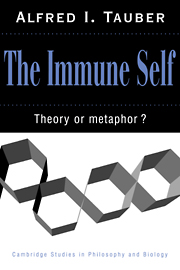Book contents
- Frontmatter
- Contents
- Acknowledgments
- Introduction
- 1 The phagocytosis theory
- 2 The triumph of immunology
- 3 The immune self declared
- 4 From theory to metaphor
- 5 Immunology gropes for its theory
- 6 The self and the phenomenological attitude
- 7 The self as organism: A philosophical consideration
- 8 The search for identity
- Notes
- References
- Index
Introduction
Published online by Cambridge University Press: 14 January 2010
- Frontmatter
- Contents
- Acknowledgments
- Introduction
- 1 The phagocytosis theory
- 2 The triumph of immunology
- 3 The immune self declared
- 4 From theory to metaphor
- 5 Immunology gropes for its theory
- 6 The self and the phenomenological attitude
- 7 The self as organism: A philosophical consideration
- 8 The search for identity
- Notes
- References
- Index
Summary
Alteration, movement without rest,
Flowing through the six empty places;
Rising and sinking without fixed law,
Firm and yielding transform each other.
They cannot be confined within a rule;
It is only change that is at work here.
– The I Ching 1967, p. 348The first lecture I give my undergraduates in courses in philosophy of science or philosophy of medicine is designed to jolt them into recognizing how profoundly what we know determines what we see. The case I use is Leonardo da Vinci's anatomic drawings, which were the unpublished product of his autopsy studies. Shortly after Pope Sixtus IV (in 1482) granted “permission to take the bodies of legally executed criminals from the place of execution, and dissect them according to medical rules and practice, ” Leonardo began a series of studies in which his Galenic prejudice distorted the accuracy of some of his drawings (Clayton 1992). A striking example is the manner in which Leonardo depicted the cerebral ventricles. As taught by Aristotle and faithfully transmitted to European anatomists and philosophers, the mind was supposed to be composed of sensory, cognitive, and memory functions; thus, Leonardo's cerebral ventricles were drawn in 1489 as three connected in-line bullous structures (ibid., pp. 26-9). When he innovatively made a wax cast of the ventricular system twenty years later, he configured it correctly (ibid., p. 74); the circulatory system, however, he never got right (nor did anyone else prior to Harvey), and when my incredulous students demand why Leonardo did not simply “draw what was there, ” I show them his exquisite and accurate rendition of the musculoskeletal system and thus demonstrate that persuasive preconceptions, suffered even by a Leonardo, can guide cognition.
- Type
- Chapter
- Information
- The Immune SelfTheory or Metaphor?, pp. 1 - 14Publisher: Cambridge University PressPrint publication year: 1994



